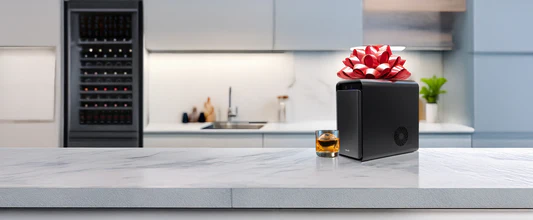Nobody wants to suffer through a long, cold winter in a drafty room that can't seem to hold in the heat. A space heater can be an excellent way to take the edge off the chill in certain rooms where your central heating system doesn't work well.
But is your space heater safe?
Fire safety and carbon monoxide poisoning are some of the biggest fears people have when it comes to wintertime heating, and for good reason. Carbon monoxide poisoning — CO poisoning for short — is often called a "silent killer" because the gas has no odor, color or flavor, so it can build up in your home without any warning signs. When it does, you may feel sleepy and pass out before you realize what's happening — and if you're incapacitated, you could die if not removed to a place with fresh oxygen quickly. Likewise, bringing a fire hazard into your living room or sleeping area can conjure up images of five-alarm blazes as seen on your local news.
That's all scary stuff, but it's important to understand your risk accurately to decide for yourself if your space heater is safe. So let's bust some myths and get the facts about space heater safety for your home.
Do Electric Space Heaters Produce Carbon Monoxide?
No. Only heaters that burn a combustible fuel to create heat can cause carbon monoxide build-up in your home. An electrical heater works by having electricity flow through a metal heating or ceramic heating element to produce heat. This may look like a series of metal fins, as in an electric baseboard heater, or perhaps large coils that look like the element in an electric oven. Either way, nothing is being burned up to create heat with an electric space heater, so carbon monoxide poisoning is not an issue.
What Kinds of Space Heaters Do Produce Carbon Monoxide?
Any fuel-burning heater can produce carbon monoxide. This molecule is created during the combustion process when fuel is on fire; specifically when incomplete combustion leaves the gas behind as a waste product. This tends to happen in systems where there's not much oxygen or open-air present; i.e. a furnace or other closed system, not an open campfire. The heaters that can produce carbon monoxide include the following:
- Gas heaters, whether fueled by propane or natural gas
- Kerosene heaters
- Wood stoves
- Fireplaces, whether wood-burning or gas-fired
Other fuel-burning appliances that run on fossil fuels can also produce carbon monoxide. Some of these include:
- Non-electric hot water heaters
- A gas range and/or oven
- Other gas appliances, such as a clothes dryer or gas grill
- Charcoal grills
- Oil, propane or gas furnaces
It should be noted that gas space heaters and the other useful items listed here are safe as long as they are installed and vented properly to preserve indoor air quality. This is why you should never use a gas stove or charcoal grill as a temporary heat source if you lose power in the winter: Unvented CO gas can quickly reach dangerous levels in your home and lead to CO poisoning.
Does an Oil-Filled Radiator Produce Carbon Monoxide?
No. This a myth based on a misunderstanding about how oil-filled space heaters work. Unlike a furnace that burns home heating oil as a fuel, an oil-filled radiator uses the oil as a heat conductor. The fins of the radiator are filled with a special oil that absorbs heat without boiling or evaporating. When the hot oil circulates through the radiator, it evenly distributes the heat and allows it to radiate into the room. At no time is the oil ever burned, so the radiant heating provided by an oil-filled space heater is perfectly safe and CO-free for your room heating needs.
Should You Have a Carbon Monoxide Detector in Rooms With Space Heaters?
It depends. If you have space heaters that burn propane, gas or kerosene as the fuel source, then CO detectors are a must. These work a lot like smoke alarms and emit a high-pitched beeping sound to alert you when the level of poisonous CO gases is too high in your home. This allows you to get outside and call the fire department for help so you don't accidentally become poisoned by breathing in too much CO. False alarms are rare, so leave immediately if yours goes off. CO alarms are also crucial for homes that use permanent heating systems or other appliances that burn fossil fuels, as listed above. In fact, most building codes now require a carbon monoxide alarm on every floor of the house.
However, if you do not have any sources of combustible fuel in your home — that is, your space heaters and whole-house heating system are electric, as are all of your appliances — then a CO detector isn't really necessary.
What Are the Symptoms of Carbon Monoxide Poisoning?
Carbon monoxide is a particularly deadly gas because it bonds easily to the hemoglobin in your blood — that's the red part designed for carrying oxygen around your body. Even if there are plenty of oxygen atoms available, they won't be able to find a place to attach to the hemoglobin, leaving your brain starved for oxygen.
Carbon monoxide poisoning is often described as arriving with flulike symptoms, including the following:
- aches and pains
- headaches
- weakness
- nausea or vomiting
- chest pain or shortness of breath
- dizziness or lightheadedness
- balance problems
- memory problems
- unconsciousness
When more than one person in a room or building have these symptoms come upon them at the same time, it's a good indication that carbon monoxide could be the cause. Open a window and leave the building at once; then call 911 for help.
Should I Worry About Carbon Dioxide Too?
Probably not. Carbon dioxide is a natural byproduct of breathing for people, plants and animals. Carbon dioxide poisoning is incredibly rare, though it is possible in industrial settings that use CO2, perhaps as dry ice. High concentrations of carbon dioxide can cause suffocation because the CO2 takes up the space that oxygen should be in, but this is much slower than the pace at which CO poisoning occurs. If you've ever kept your head beneath blankets for a long time and then felt short of breath, sleepy or somewhat dizzy, you have a sense of what it feels like to breathe in too much CO2. You are unlikely to actually poison yourself in this manner, however, and CO2 is not related to space heaters in any way.
Are Space Heaters a Fire Hazard?
They can be. According to the U.S. Consumer Product Safety Commission (CPSC), portable electric heaters cause about 1,200 house fires per year. Most fires occur when a space heater is placed too close to items that can easily ignite, such as curtains, bed linens, papers, and furniture. To reduce the risk of fire while using a space heater, follow these safety tips:
- Don't leave your space heater running unattended.
- Keep a 3-foot space around the heater clear of combustible items.
- Don't allow children and pets to play unsupervised near your space heater.
- Never plug your space heater into an extension cord.
- Do not use space heaters near a water source.
- Keep your space heater on a flat, level surface to prevent tipping.
What Safety Features Are Important in a Space Heater?
All space heaters should be UL-certified to ensure that their wiring has been tested and that no flaws have been found. You should also look for a thick, sturdy cord — preferably one with a thermal fuse that will melt and cut the power to the heater if it overheats. A thermistor is a similar safety feature that cuts power to the heater if an electrical surge is detected.
Space heaters should also have a heavy, sturdy base and a design that helps it resist tipping over. In general, a wide base and a short design is safer than a tall, slender model that could fall over if bumped. Many space heaters also feature tip-detectors that shut the heater off if it falls over. This is the best way to prevent your heater from igniting nearby material in case it tips over, since cutting the power should help it should cool off before a fire could start.
What's the Safest Space Heater Option for Families With Children?
Families with curious young children or pets should also consider choosing a space heater that doesn't get too hot to the touch in order to prevent accidental burns. Ceramic heaters are a great choice because the heating element is fully encased in a cool, plastic cover. This means that a quick, accidental touch won't burn tender skin. Instead of having heat radiate from a hot element or oil-filled radiator fins, a small fan blows across the protected ceramic element to disperse hot air without exposing the hottest part of the space heater.
Now that you have the facts about space heater safety, you can shop for the space heater that makes the most sense for your home. Whether you choose a ceramic heater, an oil-filled radiator, a propane heater or an electric baseboard, following these tips will help you keep your family safe and comfortable this winter.









1 comment
I heard many accidents happens reasons of electric heater in pas but now technology are to advance and human think first of their safety before made any inversions in the heater industry, we can see the portable fan heater available in the market now for this purpose automate and completely safe for use.